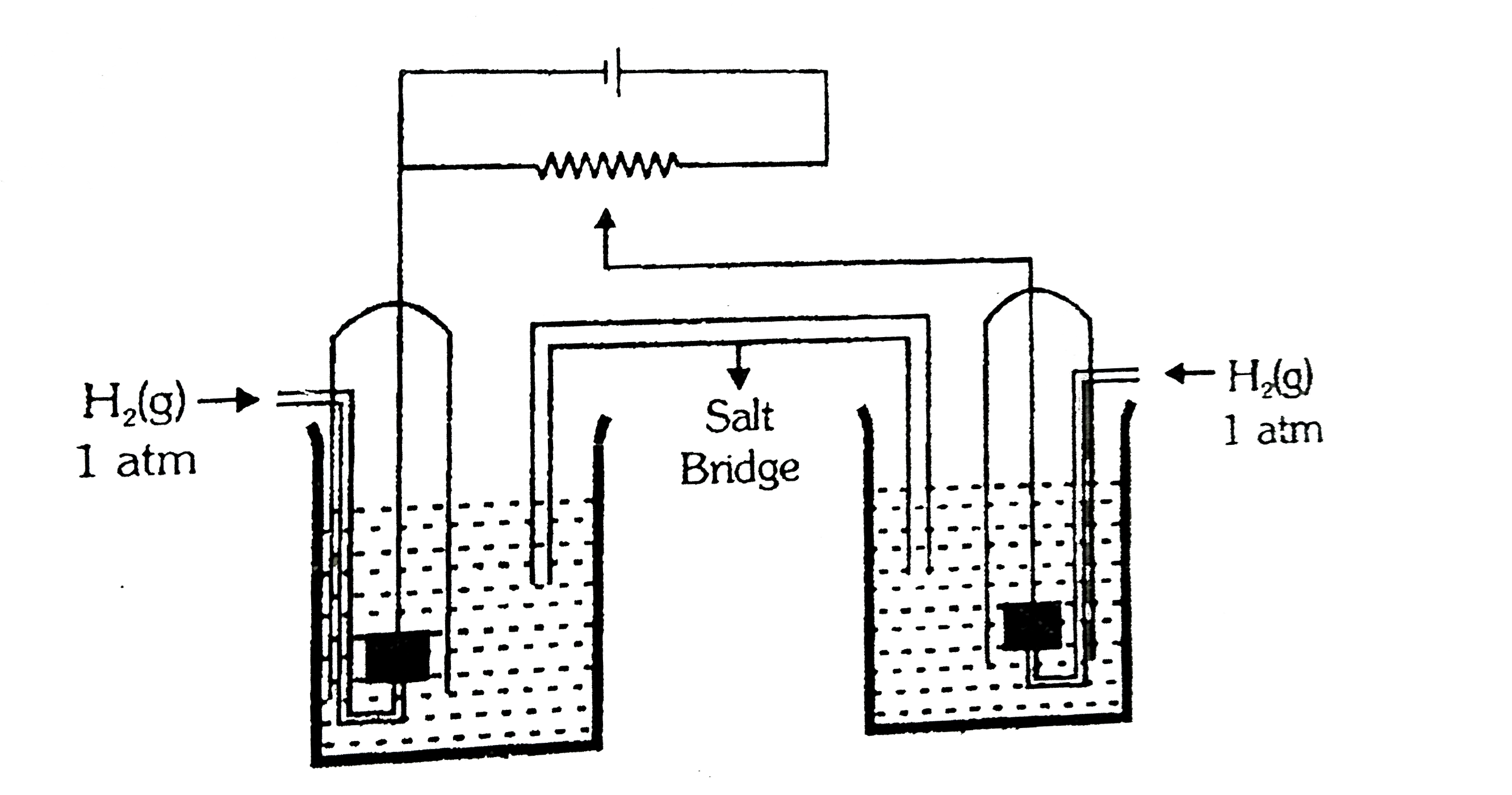What is the concentration of CH3COOH(aq.) in a solution prepared by dissolving 0.01 mole of NH+4CH3COO− in 1 L H2O? [Ka(CH3COOH))=1.8×10−5),Kb(NH4OH)=1.8×10−5)]
5.55×10−5
0.10
6.4×10−4
5.55×10−3
The correct Answer is:A
To find the concentration of acetic acid (CH₃COOH) in a solution prepared by dissolving 0.01 mole of ammonium acetate (NH₄CH₃COO) in 1 L of water, we will follow these steps:
Step 1: Understanding the Hydrolysis Reaction
Ammonium acetate is a salt formed from a weak acid (acetic acid) and a weak base (ammonium hydroxide). When dissolved in water, it hydrolyzes according to the following reaction:
NH+4(aq)+CH3COO−(aq)⇌CH3COOH(aq)+NH4OH(aq)
Step 2: Setting Up the Initial Concentrations
Initially, when 0.01 moles of ammonium acetate are dissolved in 1 L of water, the concentrations of the ions are:
- (NH+4) = 0.01 M
- (CH3COO−) = 0.01 M
- (CH3COOH) = 0 M
- (NH4OH) = 0 M
Step 3: Establishing the Change at Equilibrium
Let the degree of hydrolysis be represented by α. At equilibrium, the concentrations will be:
- (NH+4) = 0.01−α
- (CH3COO−) = 0.01−α
- (CH3COOH) = α
- (NH4OH) = α
Step 4: Writing the Hydrolysis Constant Expression
The hydrolysis constant KH can be expressed as:
KH=(CH3COOH)(NH4OH)(NH+4)(CH3COO−)
Step 5: Substituting the Equilibrium Concentrations
Substituting the equilibrium concentrations into the expression gives:
KH=α⋅α(0.01−α)(0.01−α)=α2(0.01−α)2
Step 6: Calculating KH
The hydrolysis constant KH can be calculated using the formula:
KH=KwKa⋅Kb
Where:
- Kw=1.0×10−14
- Ka=1.8×10−5
- Kb=1.8×10−5
Calculating KH:
KH=1.0×10−14(1.8×10−5)2=1.0×10−143.24×10−10≈3.09×10−5
Step 7: Setting Up the Equation
Now we can set up the equation:
3.09×10−5=α2(0.01−α)2
Assuming α is small compared to 0.01, we can approximate 0.01−α≈0.01:
3.09×10−5=α2(0.01)2
Step 8: Solving for α
Rearranging gives:
α2=3.09×10−5×(0.01)2=3.09×10−7
Taking the square root:
α=√3.09×10−7≈5.55×10−4
Step 9: Finding the Concentration of Acetic Acid
The concentration of acetic acid is given by:
(CH3COOH)=α=5.55×10−4 M
Final Answer
The concentration of acetic acid in the solution is approximately:
5.55×10−4 M
Ammonium acetate is a salt formed from a weak acid (acetic acid) and a weak base (ammonium hydroxide). When dissolved in water, it hydrolyzes according to the following reaction:
Initially, when 0.01 moles of ammonium acetate are dissolved in 1 L of water, the concentrations of the ions are:
- (CH3COO−) = 0.01 M
- (CH3COOH) = 0 M
- (NH4OH) = 0 M
Let the degree of hydrolysis be represented by α. At equilibrium, the concentrations will be:
- (CH3COO−) = 0.01−α
- (CH3COOH) = α
- (NH4OH) = α
The hydrolysis constant KH can be expressed as:
Substituting the equilibrium concentrations into the expression gives:
The hydrolysis constant KH can be calculated using the formula:
- Kw=1.0×10−14
- Ka=1.8×10−5
- Kb=1.8×10−5
Now we can set up the equation:
Rearranging gives:
The concentration of acetic acid is given by:
The concentration of acetic acid in the solution is approximately:
Topper's Solved these Questions
- IONIC EEQUILIBRIUMBOOK - NARENDRA AWASTHI ENGLISHCHAPTER - IONIC EEQUILIBRIUMEXERCISE - Level- 3
19 Videos
- IONIC EEQUILIBRIUMBOOK - NARENDRA AWASTHI ENGLISHCHAPTER - IONIC EEQUILIBRIUMEXERCISE - One or More Answer is/are Correct
1 Videos
- IONIC EEQUILIBRIUMBOOK - NARENDRA AWASTHI ENGLISHCHAPTER - IONIC EEQUILIBRIUMEXERCISE - Subjective problems
1 Videos
- GASEOUS STATEBOOK - NARENDRA AWASTHI ENGLISHCHAPTER - GASEOUS STATEEXERCISE - Subjective problems
15 Videos
- SOLID STATEBOOK - NARENDRA AWASTHI ENGLISHCHAPTER - SOLID STATEEXERCISE - Subjective Problems
13 Videos
Similar Questions
What is the concentration of CH3COOH(aq) in a solution prepared by dissolving 0.01 mole of NH+4CH3COO− in 1LH2O? Report your answer after multiplying by 9×105.
View SolutionWhat is the concentration of CH3COOH which can be added to 0.5MHCOOH solution so that dissociation of both is same.
KCH3COOH=1.8×10−5,KHCOOH=2.4×10−4
View SolutionWhat is [H+] in mol/L of a solution that is 0.20M in CH3COONa and 0.1M in CH3COOH? Ka for CH3COOH is 1.8×10−5?
View SolutionIf the concentration of[NH+4] in a solution having 0.02 M NH3and 0.005 M Ca (OH)2 is a×10−6 M,determine a.
[kb(NH3)=1.8×10−5]
View SolutionCalculate the pH of a solution containing 0.1 M CH3COOH
and 0.15 M CH3COO−.
(KaofCH3COOH=1.8×10−5)
View SolutionCalculate the e.m.f. of the cell
Pt|H2(1.0atm)|CH3COOH(0.1M)||NH3(aq,0.01M)|H2(1.0atm)|Pt
Ka(CH3COOH)=1.8×10−5,Kb,(NH3)=1.8×10−5
View SolutionCarefully observe the given figure and using data provided find the EMF of shown Galvenic cell in volt:

Solution A is 0.1M each in NH4OH and NH4CI and solution B is 0.1M each in CH3COOH and CH3COONa+.
[Given: Ka(CH3COOH)=10−5,Kb(NH4OH)=10−5 and 2.303RTF=0.06 volt]
View SolutionCalculate the percentage hydrolysis & the pH of 0.02MCH3COONH4.
Kb(NH3)−1.6×10−5,Ka(CH3COOH)=1.6×10−5
View SolutionFor NH3, Kb=1.8×10−5. Ka for NH+4 would be
View SolutionCalcualte the pH of solution when 100 mL, 0.1 M CH3COOH and 100 mL, 0.1 M HCOOH are mixed together. (Given : Ka(CH3COOH)=2×10−5),Ka(HCOOH)=6×10−5
View Solution
